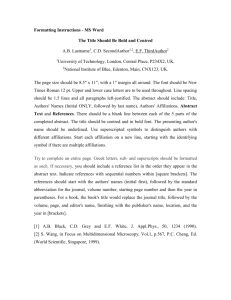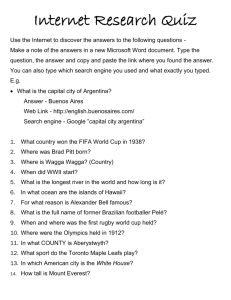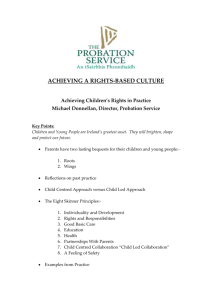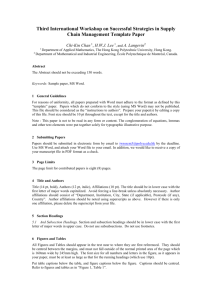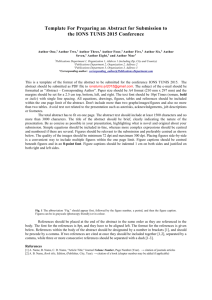Title in Bold, Centred and 16 Point with Initial Letter
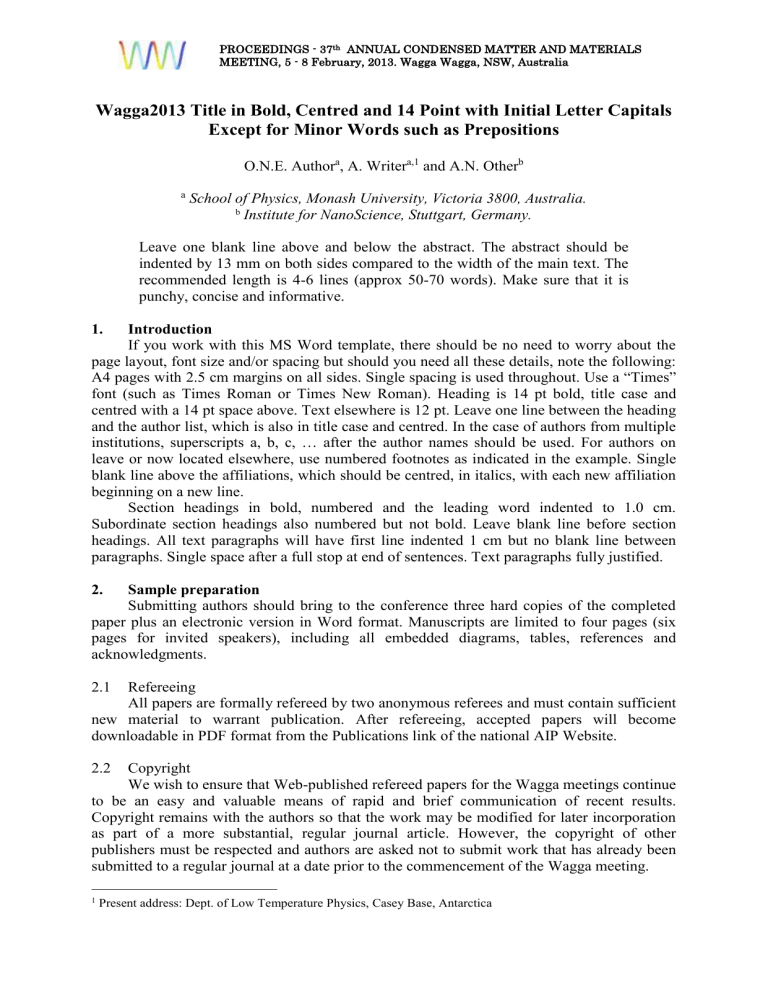
PROCEEDINGS - 37 th ANNUAL CONDENSED MATTER AND MATERIALS
MEETING, 5 - 8 February, 2013. Wagga Wagga, NSW, Australia
Wagga2013 Title in Bold, Centred and 14 Point with Initial Letter Capitals
Except for Minor Words such as Prepositions
O.N.E. Author a , A. Writer a,1 and A.N. Other b a
School of Physics, Monash University, Victoria 3800, Australia. b Institute for NanoScience, Stuttgart, Germany.
Leave one blank line above and below the abstract. The abstract should be indented by 13 mm on both sides compared to the width of the main text. The recommended length is 4-6 lines (approx 50-70 words). Make sure that it is punchy, concise and informative.
1. Introduction
If you work with this MS Word template, there should be no need to worry about the page layout, font size and/or spacing but should you need all these details, note the following:
A4 pages with 2.5 cm margins on all sides. Single spacing is used throughout. Use a “Times” font (such as Times Roman or Times New Roman). Heading is 14 pt bold, title case and centred with a 14 pt space above. Text elsewhere is 12 pt. Leave one line between the heading and the author list, which is also in title case and centred. In the case of authors from multiple institutions, superscripts a, b, c, … after the author names should be used. For authors on leave or now located elsewhere, use numbered footnotes as indicated in the example. Single blank line above the affiliations, which should be centred, in italics, with each new affiliation beginning on a new line.
Section headings in bold, numbered and the leading word indented to 1.0 cm.
Subordinate section headings also numbered but not bold. Leave blank line before section headings. All text paragraphs will have first line indented 1 cm but no blank line between paragraphs. Single space after a full stop at end of sentences. Text paragraphs fully justified.
2. Sample preparation
Submitting authors should bring to the conference three hard copies of the completed paper plus an electronic version in Word format. Manuscripts are limited to four pages (six pages for invited speakers), including all embedded diagrams, tables, references and acknowledgments.
2.1 Refereeing
All papers are formally refereed by two anonymous referees and must contain sufficient new material to warrant publication. After refereeing, accepted papers will become downloadable in PDF format from the Publications link of the national AIP Website.
2.2 Copyright
We wish to ensure that Web-published refereed papers for the Wagga meetings continue to be an easy and valuable means of rapid and brief communication of recent results.
Copyright remains with the authors so that the work may be modified for later incorporation as part of a more substantial, regular journal article. However, the copyright of other publishers must be respected and authors are asked not to submit work that has already been submitted to a regular journal at a date prior to the commencement of the Wagga meeting.
1 Present address: Dept. of Low Temperature Physics, Casey Base, Antarctica
PROCEEDINGS - 37 th ANNUAL CONDENSED MATTER AND MATERIALS
MEETING, 5 - 8 February, 2013. Wagga Wagga, NSW, Australia
3. Results
Tables and figures should be incorporated in the body of the text following, as closely as possible, the location at which they are first made reference to. When referring to a figure, table or reference in the text, use the notation Fig. 1, Fig. 2(a), Figs 1 and 2(d), Table 1, [1],
[1,3,4], [1-5], [1,3,5-9] etc. When referring to equation(s) always put the equation number(s) in brackets e.g. (1), (1-3), (1,2-3). It is not normally necessary to include the word “equation” before the number(s).
3.1 Tables
Leave one blank line between the centred, 12pt, table heading and the table, and one blank line between the table and the following text. Tables should have horizontal lines only at the top, bottom and under the column headings, with no vertical lines. Tables should be either centred or with text run around (but only for narrow tables and avoid if possible).
Table 1. Parameters from least squares fits to the spectra.
Column 1
(units 1)
Column 2 a
(units 2)
Column 3
1.0 30 vibrational
2.01 45 stretching
3.5 0.01 asleep a
Footnote added using 10 pt font in merged row
3.2 Figures
Leave one blank line above each figure and one blank line beneath the caption. Figure caption in 10 pt should be centred and placed immediately beneath the figure. Figures should be either centred or with text run around (but only for narrow figures and avoid if possible).
(c)
(b)
(a)
Fig. 1. DSC signals from samples annealed at 676 K for (a) 0 s, (b) 600 s and (c) 1200 s.
3.3 Equations
Equations should be centred with the equation number in round parentheses and right justified.
E = mc 2 (1)
PROCEEDINGS - 37 th ANNUAL CONDENSED MATTER AND MATERIALS
MEETING, 5 - 8 February, 2013. Wagga Wagga, NSW, Australia
3.4 References
References in the text are to be numbered in order of quotation, and indicated by square brackets. Examples [1-3] are given below of the preferred styles for listing references. Note the absence of punctuation except for journal abbreviations. For more complicated references, including electronic journals, translated journals, computer code, etc., use the layouts specified as the Vancouver style on the IOP web site at: http://authors.iop.org/atom/help.nsf/
7765E7F03B07DE5080257020002E4D9B/$File/IOPWordGuidelines.pdf
4. Conclusion
The IOP website recommends that you avoid using Word’s ‘Insert Symbol’ command.
Symbols inserted in this way may not appear in the PDF file of your article—they often ‘drop out’. Instead, for example, to type Greek characters, type the corresponding Latin character
(e.g., ‘a’ for ‘ ’) and manually change the font to Symbol using Format → Font and then select ‘Symbol’ font. Also avoid using the Word automatic referencing system.
Acknowledgments
This section and the References section are not numbered.
References
[1] Black J B and White V B 2002 J. Irrep. Res.
100 187
[2] Brown X J, Smith A C and Chemist A 2000 The Art of Writing Convincing Abstracts
(Oxford : Pergamon) p 868.
[3] Matter N O 1984 Industrial Applications of the Mössbauer Effect ed G J Long and J G
Stevens (New York : Plenum) p 797.

